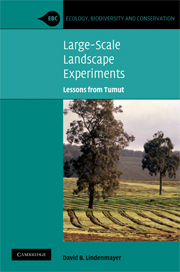Book contents
- Frontmatter
- Contents
- Preface
- Acknowledgements
- 1 The science of understanding landscape change: setting the scene for the Tumut Fragmentation Study
- 2 The theory: an overview of landscape change and habitat fragmentation
- 3 The field laboratory: the Tumut study area and the vertebrate animals it supports
- 4 Setting up the study: the design and implementation of the main cross-sectional study at Tumut
- 5 The core findings: the effects of landscape context on animals and plants
- 6 Patch use: how animals use patches of remnant eucalypt forest surrounded by pine
- 7 Theory against data: testing ecological theories and concepts
- 8 Testing PVA models with real data: melding demographic work with population modelling
- 9 Genes in the landscape: integrating genetic and demographic analyses
- 10 Refining and extending the research programme: additional studies at Tumut (and nearby) that build on the Fragmentation Study
- 11 Recommendations for plantation managers: implications for biodiversity and conservation in plantations
- 12 Lessons on running large-scale research studies: some insights from running the Tumut Fragmentation Study and directions for the future
- Appendix 1 List of collaborators/contributors to the Tumut Fragmentation Experiment
- Appendix 2 Detections of bird species in the Tumut Fragmentation Study classified by four broad classes of sites
- References
- Index
7 - Theory against data: testing ecological theories and concepts
Published online by Cambridge University Press: 20 May 2010
- Frontmatter
- Contents
- Preface
- Acknowledgements
- 1 The science of understanding landscape change: setting the scene for the Tumut Fragmentation Study
- 2 The theory: an overview of landscape change and habitat fragmentation
- 3 The field laboratory: the Tumut study area and the vertebrate animals it supports
- 4 Setting up the study: the design and implementation of the main cross-sectional study at Tumut
- 5 The core findings: the effects of landscape context on animals and plants
- 6 Patch use: how animals use patches of remnant eucalypt forest surrounded by pine
- 7 Theory against data: testing ecological theories and concepts
- 8 Testing PVA models with real data: melding demographic work with population modelling
- 9 Genes in the landscape: integrating genetic and demographic analyses
- 10 Refining and extending the research programme: additional studies at Tumut (and nearby) that build on the Fragmentation Study
- 11 Recommendations for plantation managers: implications for biodiversity and conservation in plantations
- 12 Lessons on running large-scale research studies: some insights from running the Tumut Fragmentation Study and directions for the future
- Appendix 1 List of collaborators/contributors to the Tumut Fragmentation Experiment
- Appendix 2 Detections of bird species in the Tumut Fragmentation Study classified by four broad classes of sites
- References
- Index
Summary
Ecology is characterised by a large and rapidly increasing body of theory. Empirical data are the best tests of ecological theory (Franklin and MacMahon, 2000; Krebs, 2008). Such tests are critical, especially if ecological theory is eventually to become useful in applied natural resource management, including the conservation of biodiversity (Doak and Mills, 1994; Fazey et al., 2005).
This chapter explores some of the tests of ecological theory and ecological concepts completed using datasets from Tumut. First, some results are summarised that indirectly examined the results of studies of landscape context effects (see Chapter 5) and their relationships with different conceptual models of landscape cover (see Chapter 2 for a discussion of these kinds of models). The second section of this chapter is a précis of research on nested subset theory. Third, the results of work on thresholds in the amount of native vegetation cover are outlined. Research on landscape indices is summarised in the fourth section of this chapter. The final section focuses on evidence for the peninsula effect at Tumut.
Each section of this chapter comprises a short overview of the theory or the ecological concept being examined, a summary of research findings and a brief discussion of some of the lessons that emerged from the work. In some cases, to facilitate tests of a particular ecological theory or concept, new datasets had to be gathered to complement information that had already been collected.
- Type
- Chapter
- Information
- Large-Scale Landscape ExperimentsLessons from Tumut, pp. 139 - 166Publisher: Cambridge University PressPrint publication year: 2009

